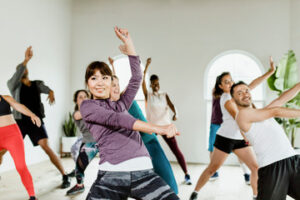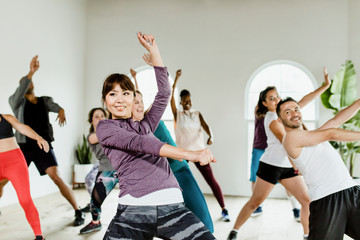Dancers stretch their bodies to develop flexibility, a skill that improves posture and can relieve muscle tension. Flexibility also helps prevent injuries.
When you take a dance class, the instructor will describe what you’ll be doing during the lesson. Then you’ll learn the moves and follow along. Dance classes are usually fast-paced and can be challenging at first. Contact Dance Lessons Wesley Chapel, FL for professional help.
Dance is a great full-body workout that strengthens muscles, increases flexibility and burns calories. It also improves balance and coordination and helps prevent osteoporosis.
While some may think that learning to dance is a waste of time, it’s actually a very good exercise for kids and adults of any age or physical ability. Dancing is a fun and social activity, as well as a fantastic way to express emotions.
A 30-minute dance class can burn between 130 and 250 calories. This makes dancing a healthy alternative to more traditional forms of exercise, such as cardiovascular workouts and weight training.
Many students take dance lessons at a private studio, community center. They might also have a class at their university, which is typically included in their tuition costs. It’s important for dancers to focus on strengthening their bodies through a variety of different methods, including adding yoga, Pilates and other group fitness classes into their weekly schedules. These types of exercises help increase the muscular endurance and strength needed to perform the technical skills that are a part of almost all dance styles.
Taking dance classes also develops the body’s spatial awareness, or proprioception, which is the ability to sense one’s position and movement in space. This is because dancers must move their arms independently of their legs, and the body must be positioned precisely in order to complete the required movements. This is a valuable skill in other activities such as sports where precise body control is essential.
The music that dancers use to accompany their moves also promotes coordination and the development of motor skills, such as hand-eye coordination. In addition to the basic steps that most dancers learn, many students also learn more advanced techniques. This requires a great deal of concentration and focus, as well as the ability to listen and follow instructions.
The ability to work together as a team is another important aspect of dance. This is because groups of dancers will often need to practice routines or synchronize their movements with others, such as during performances. Dancers can learn to work together in a group by encouraging each other, cheering each other on and supporting one another through difficult times.
Self-Esteem and Confidence
Dance classes provide an environment that promotes self-esteem. Mastering the steps of a routine or learning a new style can be challenging, but if you’re willing to work hard and persist, you will see yourself improve over time. This will help build your confidence and give you the courage to take on other challenges in life.
Many people who participate in dance also find that it helps them develop a healthier body image. This is because dance requires the use of many different muscle groups and can be a great workout, which often leads to increased strength and flexibility. People who have healthy body images are more likely to feel good about themselves and have a strong sense of self-worth.
In addition, dance can help people develop a more positive outlook on life and a stronger sense of identity. This is because dance allows people to express themselves through movement and creates a unique means of communication that enhances emotional intelligence. For example, Michael, a nine-year-old boy who struggled with anxiety, found that contemporary dance provided an outlet for him to communicate his emotions and feelings without using words.
Furthermore, dance is often performed in front of others, which can help people to become more comfortable with social interactions and build interpersonal skills. In addition, many dancers form friendships with other members of their dance studio, which can support the development of social connections and improve mental health.
Finally, the experience of overcoming dance obstacles and successes can contribute to a person’s confidence journey. This is because people learn that they can achieve their goals and succeed if they remain determined, stay focused, and persevere.
While some studies show that dance has a positive impact on a person’s self-concept, the results are not always consistent. This is because self-concept is a high-level construct that may be difficult to change through intervention programs. In contrast, studies that focus on specific aspects of self-concept like physical self-concept or dance ability tend to show more consistent improvements. Thus, more targeted interventions that focus on improving specific constructs of self-concept should be considered to increase their effectiveness.
Mental Health
Dance lessons help boost mental health by encouraging the body to release feel-good hormones known as endorphins. These hormones help improve mood, reduce anxiety and increase resilience. In addition, dancing provides a great way to relieve stress and tension from daily life by allowing individuals to focus solely on the rhythm of the music. This can be especially beneficial for those suffering from depression or Seasonal Affective Disorder.
Moreover, dancing is also an excellent social activity that can foster a sense of community. This is particularly true for those who participate in group classes, Dance Clubs and Line Dancing where participants can interact with each other and develop a support network. This is particularly important for those who may feel isolated due to mental illness, disability or old age.
Research has shown that dance can improve cognitive function and memory. This is likely because learning new steps and sequences stimulates neural pathways in the brain. These pathways are similar to those used for learning a language. Additionally, studies have found that individuals who engage in regular dance practice tend to have a better quality of life than those who do not. However, the low-to-moderate quality of many studies evaluating the effects of dance on psychological and cognitive outcomes means that clinicians should be cautious about prescribing dance as a treatment for these conditions.
High-quality studies should incorporate blinding to minimize the risk of bias, and clearly report results using standard statistical methods. They should also include a comparator group doing an active, non-dance activity to provide a more accurate picture of the benefits of dance as compared to other forms of exercise. Improvements in the quality of research in this area will enable clinicians to have greater confidence that dance can improve psychological and cognitive wellbeing. This is particularly important given the prevalence of mental illnesses, including anxiety, depression and dementia, which are associated with a sedentary lifestyle. Incorporating dance into an overall wellness program could therefore be of substantial benefit to patients and their families.
Creative Expression
Creative dance nurtures the imagination and enables children to create their own movement stories. This story-telling helps develop expressive vocabulary. It also builds motor skills, coordination and a sense of body ownership that help support healthy body awareness. Creative dance encourages personal expression while supporting the growth of self-esteem and confidence. The art of movement fosters communication and collaboration, teaches self-respect in a non-competitive environment. The integration of art, physical development and intellectual learning makes creative dance a cornucopia of opportunity for children at all ages.
In addition to promoting creativity, dance lessons teach social-emotional skills that contribute to community building. For example, dancing as part of a group supports the development of social competence as children learn to accommodate their use of force to meet group needs, work with a partner and follow a non-verbal leader. Additionally, dance studies that encourage the use of improvisation and group choreography support leadership, observation, and communication skills.
As children build strength in their bodies, they must consciously engage the muscles of the arms and legs to balance out the forces applied throughout the body. To do this, they must move with a sense of lightness. This requires a balance of tension and relaxation in the muscles, which can be practiced through improvising with the music.
During warm ups, teachers can ask children to jump for joy (jump on their spot in a joyful shape) or move quickly between a giraffe and turtle (big stretch to small, curved low level shapes). This helps them to get into the rhythm of the lesson and focus on the activity at hand.
Integrating different dance styles into educational settings is a fun and dynamic way to bring in more movement into the classroom. It can transform academics into a multi-sensory learning experience and improve the overall quality of education for students at all ages. Whether it is a history lesson, science unit, or a social skills lesson, the inclusion of dance can make a difference for both children and adults.

